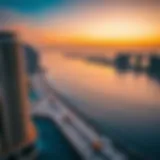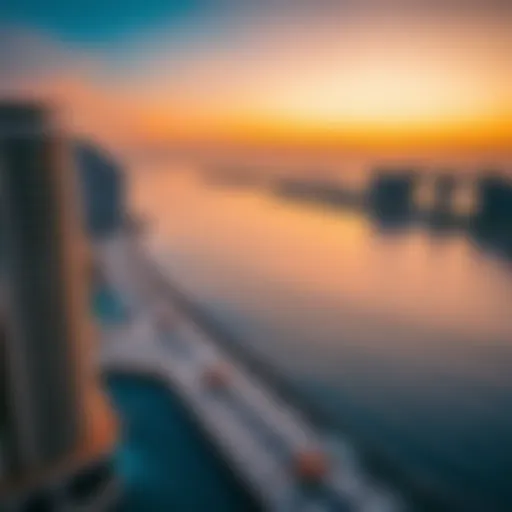Understanding Dubai International City Phase 2 Postal Code
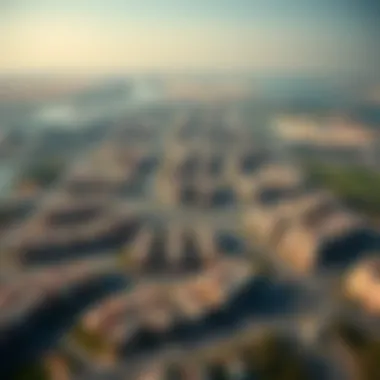

Intro
In the ever-evolving landscape of Dubai's real estate, understanding the nuances of postal codes could be quite revealing. For residents, investors, and those with an eye on the property market, the postal code associated with Dubai International City Phase 2 is more than just a symlink; it’s a critical piece of the puzzle. This surprisingly intriguing topic holds the potential to unlock insights into not just this particular area, but also into how Dubai's expansive urban planning operates.
Navigating the postal code system in Dubai, particularly in a distinctive locale like International City, can offer a window into key trends and shifts happening across the region. From comprehending how these numbers affect property values to the implications they carry for day-to-day life, grasping this aspect of real estate can be incredibly enlightening.
With that in mind, let’s delve deeper into the latest market trends shaping Dubai's real estate scene.
Prolusion to Postal Codes in Dubai
In the vast and vibrant landscape of Dubai, postal codes serve as crucial indicators that shape both the lives of residents and the operational framework of businesses. While it may seem a mere digit or a sequence of letters to some, a postal code encapsulates a wealth of information, acting as a key to unlock efficient communication and logistics. Postal codes are especially vital in bustling areas like Dubai International City Phase 2, where the flow of people and services needs to be organized and precise.
Purpose of Postal Codes
The primary role of postal codes goes beyond just sorting mail or packages. They streamline services in various facets:
- Geographic Identification: Postal codes help in precisely identifying geographic areas, enabling deliveries, services, and emergency responses to be executed with accuracy.
- Enhanced Navigation: For businesses, having accurate postal codes aids in logistics and planning. It allows for efficient routing of delivery vehicles or service crews, which is particularly beneficial for e-commerce companies and local amenities.
- Facilitation of Government Services: Postal codes support various public services like health and safety inspections or utility provisioning by ensuring that addresses are correctly classified.
There’s no denying that with every letter addressed correctly, every shipment sent smoothly, there’s a heartbeat of organization making the community tick.
Historical Context
When delving into the history of postal codes in Dubai, it becomes clear that this numerical system is relatively recent. Initially, Dubai didn’t have a structured postal coding system. For a long time, the distribution of mail relied heavily on descriptive addresses, which could leave couriers scratching their heads in confusion. However, as the city began to expand rapidly and attract a melange of residents and visitors, the demand for a more systematic approach became evident.
In 1971, the concept of postal codes was introduced as part of an effort to modernize the postal service. This marked a significant turning point in improving efficiency.
"As cities grow, so do their complexities—postal codes become the threads weaving the fabric of connection."
In subsequent years, the postal code system underwent navigational tweaks, aligning with the rapid urban development and the establishment of various community landmarks such as the International City. The codes now embed local culture, housing layouts, and infrastructure changes, making them relevant tools for residents and investors alike.
Understanding the postal code structure not only aids in logistical navigation but also paints a picture of how interconnected the various sectors of Dubai really are.
Overview of Dubai International City
Dubai International City stands as a vivid illustration of urban development that reflects the dynamic lifestyle and commercial vitality of Dubai. The significance of truly grasping the nuances of this area cannot be overstated, especially when considering how its unique characteristics impact residents, businesses, and overall property transactions. This section aims to unravel the intricacies of living and working in International City, ultimately providing a richer understanding for investors and prospective homebuyers.
Residential Features
Living in Dubai International City offers a blend of cultures and communal living that is hard to find elsewhere. The residential units, primarily consisting of low-rise apartments, are designed to cater to a diverse population, making it an attractive option for expatriates and locals alike. The architecture reflects various themes from different countries, creating an environment that feels both global and homely. Importantly, the area provides affordable housing options, which play a crucial role in Dubai’s real estate landscape. This affordability, combined with the community-centric layout, is a key consideration for anyone looking to establish roots in the city.
The area thrives with facilities that promote a well-rounded lifestyle. Parks, playgrounds, and open spaces inject a breath of fresh air into the asphalt jungle, making it a family-friendly haven. Moreover, the presence of supermarkets, schools, and healthcare facilities within reach ensures that essential needs are just a stone's throw away. Therefore, these residential features not only signify comfort but also create a sense of belonging that appeals to new residents and long-term inhabitants alike.
Commercial Opportunities
Dubai International City is not just a residential area; it also serves as a burgeoning hub for commerce. The landscape is dotted with numerous business parks, offices, and retail spaces that cater to various industries. For entrepreneurs, the locality offers lower operational costs compared to more central business districts. This makes it an appealing option for starting a business or expanding existing ventures.
Moreover, the strategic location enhances connectivity to major highways and transport links, making it easily accessible for clients and suppliers. The bustling commercial avenues within International City present opportunities ranging from traditional markets to modern retail outlets, fostering a vibrant business ecosystem. As the demand for retail and service-oriented establishments continues to grow, this area presents a promising landscape for those looking to capitalize on Dubai’s economic dynamism.
In summary, the overview of Dubai International City reveals a multifaceted locale that embodies contemporary urban living with its diverse residential features and burgeoning commercial landscapes. Understanding these elements is vital for anyone looking to navigate the property market in Dubai and grasp the potential benefits that await in this vibrant part of the city.
"Dubai International City is not just a place to live; it’s a vibrant community where cultures blend and commercial opportunities bloom."
For more insight on successful investments in Dubai real estate, tap into resources like Dubai Land Department or join discussions on platforms like Reddit to engage with current residents.
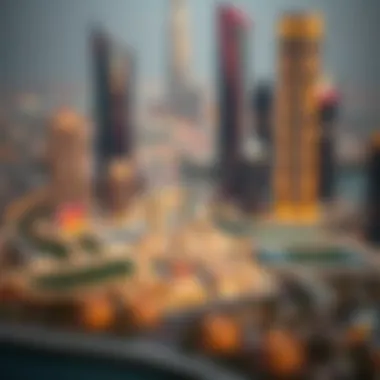

Defining Phase of International City
Phase 2 of Dubai International City represents a pivotal moment in the ongoing evolution of residential and commercial spaces within this vibrant metropolis. It stands as a testament to the city’s vision of creating a unique blend of cultural diversity, convenience, and modernity. Understanding the specifics of this phase is crucial for anyone involved in the property market, whether they’re investors, homebuyers, or real estate agents. This phase is not just about bricks and mortar; it embodies a lifestyle and an opportunity.
Development Timeline
The development timeline of Phase 2 offers a glimpse into the meticulous planning and execution that underpins its growth. Originally launched in the early 2000s, Dubai International City has seen various phases as part of the broader socio-economic strategy of the UAE. Phase 2 specifically gained traction around 2010, reflecting the growing demand for affordable yet high-quality living options in Dubai.
The completion of key infrastructural projects around this time laid the groundwork for an influx of residents and businesses. Significant milestones have marked its progress:
- 2010: Launch of Phase 2 with basic infrastructure and connectivity improvements.
- 2012: Development of residential units and commercial spaces began.
- 2015: Full operational capability of essential amenities such as schools, supermarkets, and recreational facilities.
- 2020: The phase is now equipped with expanded transport links, enhancing its accessibility.
This timeline highlights the sustained investment in the area, ensuring that the community thrives and remains attractive to new residents and business ventures alike.
Key Characteristics
The distinctive characteristics of Phase 2 make it stand out in Dubai’s bustling real estate arena. This segment is designed with a thought-out plan, focusing on several key aspects:
- Cultural Diversity: Designed to cater to a melting pot of nationalities, promoting a vibrant community spirit.
- Affordable Living: Housing options in Phase 2 are generally more budget-friendly than other areas in Dubai, making it a strong contender for first-time buyers and investors.
- Strategic Location: Its proximity to major highways and the Dubai Metro ensures that residents can access key parts of the city with minimal hassle.
- Variety of Amenities: From shopping centers to parks, this phase offers plenty of facilities enhancing the living experience.
- Sustainable Development: The emphasis on eco-friendly practices and sustainable designs aligns with Dubai's broader goals for a greener city.
These attributes combine to facilitate a symbiotic relationship between the residents and the environment, making Phase 2 an exemplary model of urban residential life. Understanding these characteristics is not just relevant for appreciation but is essential for making informed decisions when it comes to investments and property dealings.
"A well-defined area promotes not just living, but an enriching lifestyle".
In summary, Phase 2 of International City is more than a developmental phase; it is a defining chapter in Dubai’s socio-economic tapestry. Engaging with its nuanced characteristics equips individuals with a sharper insight into what the locale truly offers.
The Postal Code for International City Phase
The postal code system in Dubai plays a critical role in ensuring that communication and package deliveries flow smoothly within the bustling metropolis. When it comes to International City Phase 2, understanding its unique postal code not only aids in facilitating logistics but also enhances the broader residential and commercial experience for current and prospective stakeholders in the area.
To put it simply, a postal code acts as a beacon for deliveries, ensuring that letters and parcels find their way to the right destination promptly. For International City Phase 2, this accuracy can have far-reaching implications. Real estate agents need precise postal information to market properties effectively, businesses depend on reliable postal services for their operations, and residents also rely on it for their everyday mail sorting and delivery.
Specifics of the Postal Code
The postal code designated for International City Phase 2 is a crucial element that reflects the specific location intricacies within Dubai. This area is characterized by a mix of residential units, commercial properties, and expansive green spaces. The postal code not only contributes to the efficiency of mail delivery but serves as a point of reference for emergency services and logistical planning.
Considering the division of International City into various clusters, each cluster may indeed have its distinct postal code. Understanding these specifics can enhance the ease of locating a particular address. The central postal code for International City Phase 2 is 74510. This number may appear mundane at first glance, but it packs a punch in terms of practical utility.
Importance of Accurate Addressing
Getting the address right might seem trivial, yet in the real estate sector, it carries significant weight. Accurate addressing is paramount for a variety of reasons:
- Real Estate Transactions: In the dynamic Dubai property market, a reliable postal code can influence property values and marketability. It's not uncommon for developers to emphasize the postal code's desirability as part of their selling points.
- Communication: For businesses operating in International City Phase 2, using the correct postal code ensures that communications—be it legal documents, promotional materials, or simple correspondence—reach the desired recipient without any hiccups.
- Emergency Services: Rapid response from emergency services hinges on accurate addressing. When every second counts, knowing the exact postal code can save precious time in critical situations.
The ripple effect of accurate addressing extends to the community's overall perception of the area. A consistent and clearly defined postal code fosters trust and reliability among residents and businesses alike.
"In today’s fast-paced world, the minutiae can make a world of difference. Knowing your postal code means more than just mail; it shapes your interactions in the entire Dubai ecosystem."
Whether you are a potential buyer, a current resident, or an investor, understanding the dynamics around the postal code for International City Phase 2 opens up a wealth of insights about the area's living conditions and business opportunities. Much of the value can be pinned down to how well information flows, and postal codes are an essential cornerstone of this flow.
Navigating Life in International City Phase
Navigating life in International City Phase 2 is essential for both residents and businesses alike. This area is not just a hub of residential living; it’s a vibrant community that offers a wealth of amenities and access to a variety of transportation links. Understanding these elements is crucial for anyone looking to settle in or invest in the area.
Access to Amenities
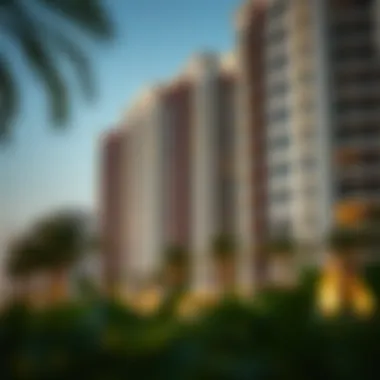

The amenities available in International City Phase 2 play a vital role in enhancing the quality of life for its residents. With a comprehensive array of shopping centers, parks, and recreational facilities, day-to-day living becomes more convenient and enjoyable.
- Supermarkets and Retail Stores: Easy access to stores such as Carrefour ensures that daily shopping needs are catered to without the hassle of long commutes.
- Dining Options: The area boasts a range of restaurants, from casual eateries to fine dining, which cater to diverse culinary tastes.
- Health Care Facilities: Proximity to medical centers enhances residents' sense of security, offering peace of mind knowing healthcare is nearby.
- Community Spaces: Parks and recreational areas allow families to spend time outdoors, encouraging a sense of community and belonging.
All these elements contribute to making life in International City Phase 2 both convenient and fulfilling. The careful planning and development of amenities cater directly to the needs of the residents, ensuring that everything required for a comfortable lifestyle is within reach.
Transportation Links
Transportation is another critical aspect that influences the lifestyle in International City Phase 2. Efficient transport links make commuting easy and connect residents to other key areas of Dubai. This accessibility plays a significant role for daily commuters and those looking to explore the wider region.
- Road Connectivity: Major highways such as Sheikh Mohammed Bin Zayed Road provide seamless connections to central Dubai, making travel not only quicker but also more efficient.
- Public Transport Options: The presence of bus services offers an affordable alternative to private transport, further easing travel for residents who prefer not to drive.
- Proximity to Metro: Although the immediate area may not have a metro station, nearby stations can be reached within a short drive, enhancing public transport options for daily commuting.
In summary, reliable transportation links ensure residents can navigate both their local area and the broader city with ease, promoting a smoother and more connected living experience.
"Navigating life in International City Phase 2 is much more than just a postal code; it’s about understanding how the amenities and transport options integrate to enhance living standards here."
These interconnected aspects of life within International City Phase 2 markedly contribute to the area's allure. It’s a blend of convenience and modern living that appeals to investors and new homebuyers, making it an attractive location in the ever-evolving landscape of Dubai real estate.
Impact of Postal Codes on Property Transactions
In the real estate market of Dubai, the role of postal codes cannot be underestimated. Especially for areas like Dubai International City Phase 2, the postal code serves not just as a sticker on an envelope. It’s central to a variety of functions that enhance the buying and selling processes, thus impacting property transactions significantly.
Enhancing Clarity in Real Estate Deals
The importance of postal codes in real estate deals is akin to the base notes in a fine perfume; without them, the whole composition can become muddled. Accurate postal codes ensure that both buyers and sellers know exactly where properties are located. This clarity reduces confusion during the negotiation phase, which, you could say, is where the rubber meets the road.
A well-defined postal code can prevent potential complications related to misdirected correspondence or misidentification of property locations. For instance, if someone is looking at various listings in Dubai International City Phase 2, having the correct postal code can lead them directly to neighborhoods or clusters that interest them. It streamlines the entire property search process, resulting in more informed decisions.
Additionally, accurate postal coding simplifies the mapping of property values in relation to amenities and services. When evaluating a property, buyers often consider distance to schools, malls, and parks. If postal codes are unreliable, one might overpay for a property nearer to these conveniences or miss opportunities altogether.
Facilitating Communication with Authorities
On another front, the role of postal codes in facilitating communication with authorities cannot be overlooked, especially for investors and current residents. Imagine filing for a permit or accessing public services; incorrect postal codes can lead to delays as much as a flat tire can halt a road trip.
Postal codes act as a lifeline for regulatory bodies to categorize locations accurately. For homeowners in Dubai International City Phase 2, this means quicker responses from utility companies, waste management services, and local councils. Whether it’s filing complaints, requesting additional services, or simply reaching out for information, having the correct postal code can accelerate processes significantly.
Moreover, when developers submit plans to local authorities, the postal code allows for effective zoning and planning evaluations. It ensures that projects are appropriately analyzed based on their geographical context, streamlining approvals and enhancing development efficiency.
"Adhering to postal codes ensures that communication remains seamless between property owners and local authorities, minimizing effort and maximizing results."
In short, navigating property transactions in Dubai International City Phase 2 with a specific and accurate postal code not only shores up operational efficiency but also cultivates trust. For potential buyers and seasoned investors alike, understanding the nuances of postal codes is crucial in making sound real estate decisions within this vibrant locale.
Emerging Trends in Dubai Real Estate
In the constantly shifting landscape of Dubai's real estate market, emerging trends play a pivotal role in shaping the future. Understanding these trends isn’t just crucial for investors, homebuyers, and real estate agents; it's essential for anyone looking to grasp the broader economic implications of property development in the region. With each passing year, buyer preferences evolve, influenced by a multitude of factors, while infrastructure development creates new opportunities and challenges.
Evaluating the recent trends helps stakeholders make informed decisions, especially regarding Dubai International City Phase 2. Knowing what’s on the horizon can mean the difference between a savvy investment and a missed opportunity.
Shifts in Buyer Preferences
Recent shifts in buyer preferences highlight a more demand for sustainability and lifestyle-centric living environments. More people are leaning towards homes that offer smart technology, energy efficiency, and access to green spaces. These preferences are changing the way developers approach projects. For instance, buyers are increasingly valuing open areas for recreation and socializing, rather than merely focusing on property size.
- Sustainability: There is a notable shift toward eco-friendly living, with buyers expressing an increasing enthusiasm for energy-efficient homes. This not only reflects a willingness to invest in their wellbeing but also indicates a growing consciousness about environmental issues.
- Lifestyle Amenities: Modern-day homebuyers often prefer locations that provide convenient access to schools, healthcare, and entertainment facilities. For example, Dubai International City Phase 2 is gradually incorporating family-friendly amenities that align with these emerging preferences.
- Community Feel: The desire for a sense of community is also rising. More investors are drawn to developments that foster a closer-knit community where neighbors know each other, thus enhancing the living experience.
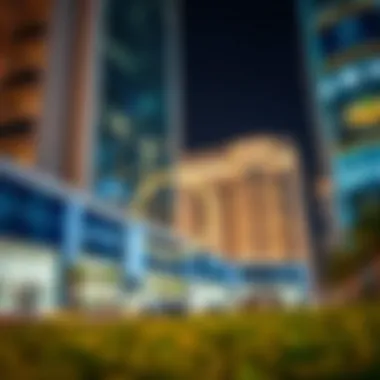

As these shifts unveil themselves, developers must adapt, ensuring their projects meet the evolving demands. Understanding buyer preferences allows for more strategic planning and marketing, maximizing appeal to potential residents.
Influence of Infrastructure Development
Infrastructure development in Dubai is not just about erecting new buildings or roadways; it forms the backbone of economic and social progress. Improved infrastructure opens doors to greater connectivity and accessibility, which in turn can lead to increased property values.
- Accessibility: Enhanced transport links such as Metro extensions or new road systems can greatly reduce travel time for residents. For instance, international City Phase 2's proximity to major highways may enhance its attractiveness to buyers seeking ease of commuting.
- New Facilities: With the government balancing infrastructure improvements alongside development, there's often the introduction of schools, shopping centers, and healthcare facilities. These additions are crucial as they make living in certain areas more feasible and desirable.
- Economic Boost: Finally, robust infrastructure can stimulate the local economy by attracting businesses and tourists alike. This creates a ripple effect, increasing demand for housing and raising the overall appeal of investing in the area.
"In Dubai, infrastructure isn't just concrete and steel—it's about paving the way for future growth."
By understanding the influence of these infrastructure developments, investors and homebuyers can better gauge the long-term potential of properties in Dubai International City Phase 2 and beyond.
Future Considerations for International City
As the landscape of Dubai continues to evolve, the International City Phase 2 stands at a significant crossroads. Understanding future considerations for this region not only highlights the potential of its growth but also sheds light on opportunities that might arise for various stakeholders, from residents to investors. The dynamic nature of real estate, coupled with infrastructural advancements, calls for an examination of both current trends and future projections.
Potential for Expansion
International City, with its unique architecture and diverse cultural appeal, lays a solid foundation for potential growth. Expansion plans may stem from a combination of resident demands and economic imperatives. The government has plans to enhance connectivity within this area with improved road networks and public transport, effectively boosting the accessibility of International City Phase 2.
Moreover, rising consumer interest in more spacious and holistic living environments could lead to an increase in housing supply. For instance, if property developers take the plunge and invest in building new residential units, they’re likely to attract a broad swath of the demographic spectrum—ranging from young families to professionals seeking community-oriented living.
- Enhanced Infrastructure: Investment in public transport like metro lines can significantly increase real estate values.
- Mixed-use Developments: Incorporating commercial spaces within residential complexes may facilitate a lively community, drawing in more residents.
- Diverse Lifestyle Options: As amenities mature, prospective buyers will likely prioritize areas with access to schools, hospitals, and entertainment.
Long-term Investment Opportunities
Investors eyeing Dubai's property market should keep a keen lookout on International City Phase 2 for several compelling reasons. The ongoing development often translates into potential long-term gains. The area boasts affordable pricing compared to other regions, making it an attractive entry point.
Several factors bolster the argument for long-term investment:
- Government Initiatives: City planners understand the essential role of International City in Dubai's overall growth, turning a keen eye toward sustainable development efforts.
- Cultural Diversity: The unique blend of lifestyles and cultures encourages a vibrant community—factors that can elevate demand and, consequently, property values.
- Proximity to Business Hubs: Being in close quarters with several key business districts offers immense advantages for investors, especially if commercial opportunities sprout in the area.
Overall, investing now might yield substantial returns in the future as demand for housing spikes owing to both local habitation trends and global economic shifts.
Expansive growth and development changes can often catch investors off guard, making it crucial to analyze trends and position oneself strategically for future gains.
Ending
This conclusion serves to wrap up the various threads explored throughout this article regarding the postal code associated with Dubai International City Phase 2. Understanding this postal code proves significantly valuable for multiple stakeholders at play, including investors, homebuyers, and real estate agents. It is not merely a string of numbers; it's an essential aspect of navigating the real estate landscape in this vibrant locale.
Recap of Key Points
Here are the touchstone insights that emerge from our analysis:
- Purpose of Postal Codes: They facilitate the organization and delivery of mail and packages, playing a crucial role in the infrastructure of urban life.
- Specifics of International City Phase 2's Postal Code: Knowing this code is paramount for ensuring smooth transactions and seamless communication with service providers or postal services.
- Impact on Property Transactions: Accurate postal codes can lead to clearer property listings, assisting buyers and renters in making informed decisions.
- Emerging Trends and Future Considerations: The potential for expansion and developments impacting investor strategies in this area were examined, paving the way for promising opportunities.
All these elements converge to create a comprehensive understanding of how essential an accurate postal code is to the functioning of International City Phase 2.
Invitation for Further Exploration
As we step back from our in-depth exploration, it’s an opportune moment to encourage further inquiry into the dynamics of Dubai's real estate market and the pivotal role of postal codes. The evolving nature of urbanization in Dubai means that the real estate environment is likely to shift.
Consider delving into additional facets such as:
- Comparative Analysis with Other Developments: Explore how postal codes in other areas of Dubai compare to those in International City Phase 2.
- Community Engagement: Join forums, discussions, or attend local meetings to hear firsthand from residents and investors about their experiences.
- Accessing Government Resources: Engaging with Dubai's Land Department or Dubai Statistics Center can provide valuable insights into demographic shifts and property valuation trends.
In summary, the postal code of Dubai International City Phase 2 is a key aspect of navigating the real estate landscape, ensuring that all parties involved operate efficiently and effectively. As conditions evolve, staying informed will empower the various stakeholders involved and enhance opportunities within this compelling market.
"In the intricate tapestry of urban living, every thread is significant. The postal code is one of these essential threads that weaves through the fabric of community and commerce."
For more information, consider visiting relevant resources like Dubai Land Department, Wikipedia on Postal Codes, or engaging with discussions on Reddit.














